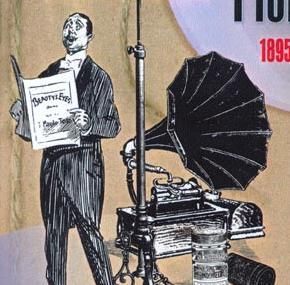Starting in the late 19th century, the major product sold by the music industry was the piano roll. There were no radios, TV, record players or movies.
 But most homes had a piano, and even though a great number of people learned to play the piano in those days, the piano roll gave them the opportunity to hear many styles of music and virtuosos.
But most homes had a piano, and even though a great number of people learned to play the piano in those days, the piano roll gave them the opportunity to hear many styles of music and virtuosos.
As popular music gained strength in the entertainment world — eclipsing classic and religious music — music publishers flourished and cultivated songwriters. The area of New York where most held offices was called Tin Pan Alley.
Here is a brief article about this magical place and its role in popular music — after the jump.
WADE
Tin Pan Alley is a term that is synonymous with the American music publishing industry. But, is there actually a Tin Pan Alley, how did it get its name and why has it become a byword for the music industry?
In the late nineteenth century, 25,000 pianos were sold in the United States each year and, with over half a million youngsters learning to play the instrument, there was a huge demand for sheet music. Indeed the clamour was so huge that publishers rushed to enter the lucrative market.
Before long, 1885 publishers were scattered throughout the large cities of the continental USA, but during the last 15 years of the century they all began to graduate towards New York as the city’s prominence as the center for the production of the musical arts grew. It was here that publishers adopted new, aggressive business practices and marketing techniques to achieve phenomenal sales.
The publishers tied talented and popular composers to exclusive contracts; they also conducted market research seeking out which style of music was currently the most popular. Then they would task their contract composers to produce works in that genre, thus immediately tapping into the lucrative market.
By the turn of the century many notable publishers had their offices on 28th Street between Broadway and 5th Avenue, and this is the area that became known as Tin Pan Alley.
How it became to be known by that moniker is subject to a degree of urban legend, but the general consensus is that it is down to a visiting journalist by the name of Monroe Rosenfeld. He described the area as being drowned in a cacophony of noise emanating from the many producers’ offices, sounding as though hundreds of people were bashing tin pans. He used it several times in his newspaper articles in the early twentieth century and the term stuck.
One of the earliest Tin Pan Alley success stories was the composition ‘After the Ball’, written by Charles Harris, which sold close to six millions copies of sheet music. Other well-known Tin Pan Alley compositions from the early 1900s include ‘Give My Regards to Broadway’, ‘Shine on Harvey Moon’ and ‘Let Me Call you Sweetheart’, to which most people can hum the melodies and even recite the words!
If you wish to plan a visit to the legendary Tin Pan Alley and want to stay nearby, remember that hotels in Times Square are expensive, so make sure you have sufficient funds to enjoy your break and don’t blow your entire budget on accommodation.
Retrieved from “http://www.articlesbase.com/music-articles/tin-pan-alley-home-to-new-yorks-music-publishers-198824.html”
About the Author:
Adam Singleton is an online, freelance journalist and keen amateur photographer from Scotland. His interests include travelling and hiking.

“Live In Tokyo”, Japan 01/24/85 I think this was his best performance ever. Hey fellas! for more srv’s videos check out: www.youtube.com (more)
Video Rating: 4 / 5
Leave a Comment